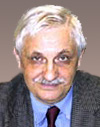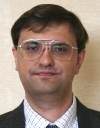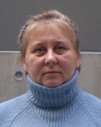 |
 |
 |
 |
 |
Professor |
Assistant Professor |
Assistant Professor |
Visiting Professor |
Visiting Professor |
- Semiconductor classical and quantum heterostructure devices operating in the terahertz range of frequencies (terahertz detectors, mixers, generators, and photomixers).
- The theory and computer modeling of graphene-based devices - the basis of future Carbon electronics.
- Quantum-well and quantum-dot infrared photodetectors (QWIPs and QDIPs), QWIP- and QWIP-based functional devices.
- Theory and computer modeling of zero-resistance and zero-conductance states in two-dimensional electron systems irradiated with microwaves and related phenomena.
- Rensselaer Polytechnic Institute (Troy, USA)
- Tohoku University (Sendai, Japan),
- University at Buffalo (Buffalo, USA),
- Moscow Institute of Physics and Technology,
- Ioffe Physical-Technical Institute (St. Petersburg, Russia),
- Gothenburg University (Gothenburg, Sweden), and others.
|
The research activity of the Computer Solid State Physics Laboratory is focused on theoretical studies and computer modeling of physical processes in semiconductor micro- and nanostructures and in novel electronic and optoelectronic classical and quantum devices based on such structures. A substantial part of activity of the laboratory is associated with the development of interactive educational resources and materials. Since the laboratory establishment in 1993, its members have published more than 130 journal articles and made more than 140 presentations at international conferences. One of the members of the laboratory is a Fellow of the Institute of Electrical and Electronics Engineers (IEEE), Fellow of the American Physical Society, and Corresponding member of the Russian (national) Academy of Sciences. Two professors are the IEEE Senior Members. The research efforts of the laboratory members are now centered on theory andcomputer modeling of: The computer Solid State Physics Laboratory conducts research in cooperation with leading research groups at: |
Refereed Journal Papers
| [m-ryzhii-01:2006] |
V. Ryzhii, M. Ryzhii, Y. Hu, I. Hagiwara, and M.S. Shur. Resonantdetection of modulated terahertz radiation in micromachined highelectron-mobility transistor. Appl. Phys. Lett., page accepted for publication, 2007. |
| The authors develop a device model for a resonant detector of modulate terahertz radiation based on a micromachined high-electron-mobility transistor with the microcantilever serving as the gate. The device model accounts
for mechanical motion of the microcantilever and plasma effects of the twodimensional electron channel. It is demonstrated that at a combined resonance
when the carrier terahertz frequency and the modulation frequency coincide
with the plasma resonant frequency and the mechanical resonant frequency, respectively, the amplitude of the output gate and drain ac currents and, hence,
the detector resonsivity exhibit sharp and high maximum. |
|
| [m-ryzhii-02:2006] |
M. Ryzhii and V. Ryzhii. Injection and population inversion in
electrically induced p-n junction in graphene with split gates. Jpn. J.
Appl. Phys., 46(8):L151.L153, 2007. |
| We study electron and hole injection processes in a forward biased p-n junction electrically induced in a graphene heterostructure with split gates and calculate the ac conductivity associated with the interband and intraband transitions under the conditions of population inversion. It is shown that the net conductivity can be negative in the terahertz range of frequencies, so that the electrically induced p-n junctions in graphene heterostuctures might be used in sources of coherent terahertz radiation. |
|
| [m-ryzhii-03:2006] |
V. Ryzhii, M. Ryzhii, and T. Otsuji. Negative dynamic conductivityof graphene with optical pumping. J. Appl. Phys., page accepted
for publication, 2007. |
| We study the dynamic ac conductivity of a nonequilibrium two-dimensional electron-hole system in optically pumped graphene. Considering the contribution of both interband and intraband transitions, we demonstrate that at
sufficiently strong pumping the population inversion in graphene can lead to
the negative net ac conductivity in the terahertz range of frequencies. This effect might be used in graphene-based coherent sources of terahertz radiation. |
|
| [m-ryzhii-04:2006] |
V. Ryzhii, I. Khmyrova, M. Ryzhii, A. Satou, T. Otsuji,
V. Mitin, and M.S. Shur. Terahertz plasma waves in two-dimensionalelectron systems and their device applications. Int. J. High Speed Electron. Syst., 17(3):accepted for publication, 2007. |
| We overview the plasma properties of a two-dimensional electron gas in semiconductor
heterostructures as well as new concepts and proposals of novel
terahertz devices (detectors, sources utilizing plasma instabilities, and photomixers)
based on these heterostructures. |
|
| [m-ryzhii-05:2006] |
M. Ryzhii and V. Ryzhii. Population inversion in electrically
and optically pumped graphene. Physica E, accepted for publication,
2007. |
| We find the electron and hole distribution functions and calculate the dynamic
conductivity of nonequilibrium two-dimensional (2D) electron-hole systems in
graphene-based structures under the injection or optical pumping. Both the
interband transitions and intraband transitions associated with the electron
and hole scattering on impurities and acoustic and optical phonons are considered.
It is shown that under sufficiently strong pumping, the population
inversion may result in the negative net dynamic AC conductivity in a certain
range of photon frequencies. Since the frequencies corresponding to the negative
conductivity fall into the terahertz range, the predicted effects might be
used in coherent sources of terahertz radiation. |
|
| [m-ryzhii-06:2006] |
V. Ryzhii, M. Ryzhii, I. Khmyrova, T. Otsuji, and Shur M.S.
Resonant terahertz photomixing in integrated high-electron-mobility
transistor and quantum-well infrared photodetector device. Jpn. J.
Appl. Phys., 45(4B):3648.3651, 2006. |
| We propose a novel heterostructure device for generating of terahertz (THz) radiation
based on the integration of a high-electron-mobility transistor (HEMT)
and a quantum-well infrared photodetector (QWIP) and utilizing the photomixing
of middle- or far-infrared optical signals. The operation of the photomixer
under consideration is associated with the resonant excitation of
plasma oscillations in the device HEMT section brought about by the transient
photocurrent produced in the QWIP by incident infrared radiation. Using the
developed device model for HEMT-QWIP photomixers which combines both
the analytical description of electron processes and their ensemble Monte Carlo
particle modeling, we evaluate the device performance. |
|
| [v-ryzhii-01:2006] |
V. Ryzhii and Shur M.S. Resonant terahertz detector utilizing
plasma oscillations in two-dimensional electron system with lateral
schottky junction. Jpn. J. Appl. Phys., 45(42):L1118.L1120, 2006. |
| We propose a novel resonant detector of terahertz radiation based on a heterostructure
with an ungated two-dimensional electron channel, with a lateral
Schottky junction at one of the channel edges, substantiate its operation, and
evaluate the device characteristics. We demonstrate that the detector responsivity
can exhibit sharp resonant maxima at the frequencies pertaining to the
plasma oscillations. As shown, the peak values of the responsivity of the detector
proposed can exceed the responsivity of the standard Schottky detectors by
several orders of magnitude if the electron mobility in the channel is sufficiently
high. |
|
| [v-ryzhii-02:2006] |
V. Ryzhii, A. Satou, and T. Otsuji. Plasma waves in twodimensional
electron-hole system in gated graphene heterostructures.
J. Appl. Phys., 101:024509(5), 2006. |
| Plasma waves in the two-dimensional electron-hole system in a graphene-based
heterostructure controlled by a highly conducting gate are studied theoretically.
The energy spectra of two-dimensional electrons and holes are assumed
to be conical (neutrinolike), i.e., corresponding to their zero effective masses.
Using the developed model, we calculate the spectrum of plasma waves (spatiotemporal
variations of the electron and hole densities and the self-consistent
electric potential).We find that the sufficiently long plasma waves exhibit a linear
(soundlike) dispersion, with the wave velocity determined by the gate layer
thickness, the gate voltage, and the temperature. The plasma wave velocity in
graphene heterostructures can significantly exceed the plasma wave velocity
in the commonly employed semiconductor gated heterostructures. The gated
graphene heterostructures can be used in different voltage tunable terahertz
devices which utilize the plasma waves. |
|
| [v-ryzhii-03:2006] |
V. Ryzhii. Terahertz plasma waves in gated graphene heterostructures.
Jpn. J. Appl. Phys., 45(35):L923.L925, 2006. |
| Plasma waves in graphene-based heterostructures with massless (neutrino-like)
two-dimensional electron gas and with a highly conducting substrate (n+-Si)
serving as a gate and an isolating gate layer (SiO2) are studied. Using the
developed model, we show that the sufficiently long plasma waves exhibit a
linear (sound-like) dispersion with the wave velocity determined by the gate
layer thickness and the gate voltage. The plasma wave velocity in graphene
heterostructures can significantly exceed the plasma wave velocity in the commonly
employed semiconductor gated heterostructures. The gated graphene
heterostructures can be used in different novel voltage tunable THz devices
which utilize the plasma waves. |
|
| [v-ryzhii-04:2004] |
M. Ryzhii and V. Ryzhii. Injection and population inversion in
electrically induced p-n junction in graphene with split gates. Jpn. J.
Appl. Phys., 46(8):L151.L153, 2007. |
| We study electron and hole injection processes in a forward biased p-n junction
electrically induced in a graphene heterostructure with split gates and calculate
the ac conductivity associated with the interband and intraband transitions
under the conditions of population inversion. It is shown that the net conductivity
can be negative in the terahertz range of frequencies, so that the
electrically induced p-n junctions in graphene heterostuctures might be used
in sources of coherent terahertz radiation. |
|
| [v-ryzhii-05:2006] |
M. Ryzhii and V. Ryzhii. Population inversion in electrically
and optically pumped graphene. Physica E, accepted for publication,
2007. |
| We find the electron and hole distribution functions and calculate the dynamic
conductivity of nonequilibrium two-dimensional (2D) electron-hole systems in
graphene-based structures under the injection or optical pumping. Both the
interband transitions and intraband transitions associated with the electron
and hole scattering on impurities and acoustic and optical phonons are considered.
It is shown that under sufficiently strong pumping, the population
inversion may result in the negative net dynamic AC conductivity in a certain
range of photon frequencies. Since the frequencies corresponding to the negative
conductivity fall into the terahertz range, the predicted effects might be
used in coherent sources of terahertz radiation. |
|
| [v-ryzhii-06:2006] |
V. Ryzhii, M. Ryzhii, Y. Hu, I. Hagiwara, and M.S. Shur. Resonant
detection of modulated terahertz radiation in micromachined highelectron-
mobility transistor. Appl. Phys. Lett., page accepted for publication,
2007. |
| The authors develop a device model for a resonant detector of modulated
terahertz radiation based on a micromachined high-electron-mobility transistor
with the microcantilever serving as the gate. The device model accounts
for mechanical motion of the microcantilever and plasma effects of the twodimensional
electron channel. It is demonstrated that at a combined resonance
when the carrier terahertz frequency and the modulation frequency coincide
with the plasma resonant frequency and the mechanical resonant frequency, respectively,
the amplitude of the output gate and drain ac currents and, hence,
the detector resonsivity exhibit sharp and high maximum. |
|
| [v-ryzhii-07:2006] |
E. Vostrikova, A. Ivanov, I Semenikhin, and V. Ryzhii. Electrical
excitation of shock and solitonlike waves in two-dimensional electron
channels. Phys. Rev. B, page accepted for publication, 2007. |
| We study the electrical excitation of nonlinear plasma waves in heterostructures
with two-dimensional electron channels and with split gates, and the
propagation of these waves using hydrodynamic equations for electron transport
coupled with two-dimensional Poisson equation for self-consistent electric
potential. The term related to electron collisions with impurities and phonons
as well as the term associated with viscosity are included into the hydrodynamic
equations.We demonstrate the formation of shock and solitonlike waves
as a result of the evolution of a strongly nonuniform initial electron density
distribution. It is shown that the shock wave front and the shape of solitonlike
pulses pronouncedly depend on the coefficient of viscosity, the thickness of the
gate layer, and the nonuniformity of the donor distribution along the channel.
The electron collisions result in the damping of the shock and solitonlike waves,
while they do not markedly affect the thickness of the shock wave front. |
|
| [v-ryzhii-08:2006] |
V. Ryzhii, A. Satou, W. Knap, and M. S. Shur. Plasma oscillations
in high-electron-mobility transistors with recessed gate. J. Appl.
Phys., 99:084507(5), 2006. |
| We calculate the plasma oscillation spectrum in high-electron-mobility transistors
(HEMTs) with recessed gate having the highly doped caps adjacent
to the source and drain contacts and the windows between the caps and the
gate. The resonant plasma frequencies are found as functions of the lengths of
the gate, cap, and window regions, the electron concentration in the transistor
channel, and the gate voltage. We demonstrate that the effect of cap region
can result in a significant reduction of the resonant frequencies in comparison
with those calculated for simplified HEMT model. This can provide a plausible
explanation of the data obtained in recent experimental studies of the
detection of terahertz radiation in and its emission from HEMTs. |
|
| [v-ryzhii-9:2006] |
V. Ryzhii, M. Ryzhii, and T. Otsuji. Negative dynamic conductivity
of graphene with optical pumping. J. Appl. Phys., page accepted
for publication, 2007. |
| We study the dynamic ac conductivity of a nonequilibrium two-dimensional
electron-hole system in optically pumped graphene. Considering the contribution
of both interband and intraband transitions, we demonstrate that at
sufficiently strong pumping the population inversion in graphene can lead to the negative net ac conductivity in the terahertz range of frequencies. This effect
might be used in graphene-based coherent sources of terahertz radiation. |
|
| [v-ryzhii-10:2006] |
V. Ryzhii, M. Ryzhii, I. Khmyrova, T. Otsuji, and Shur M.S.
Resonant terahertz photomixing in integrated high-electron-mobility
transistor and quantum-well infrared photodetector device. Jpn. J.
Appl. Phys., 45(4B):3648.3651, 2006. |
| We propose a novel heterostructure device for generating of terahertz (THz) radiation
based on the integration of a high-electron-mobility transistor (HEMT)
and a quantum-well infrared photodetector (QWIP) and utilizing the photomixing
of middle- or far-infrared optical signals. The operation of the photomixer
under consideration is associated with the resonant excitation of
plasma oscillations in the device HEMT section brought about by the transient
photocurrent produced in the QWIP by incident infrared radiation. Using the
developed device model for HEMT-QWIP photomixers which combines both
the analytical description of electron processes and their ensemble Monte Carlo
particle modeling, we evaluate the device performance. |
|
| [v-ryzhii-11:2006] |
V. Ryzhii, I. Khmyrova, M. Ryzhii, A. Satou, T. Otsuji,
V. Mitin, and M.S. Shur. Terahertz plasma waves in two-dimensional
electron systems and their device applications. Int. J. High Speed Electron.
Syst., 17(3):accepted for publication, 2007. |
| We overview the plasma properties of a two-dimensional electron gas in semiconductor
heterostructures as well as new concepts and proposals of novel
terahertz devices (detectors, sources utilizing plasma instabilities, and photomixers)
based on these heterostructures. |
Refereed Proceeding Papers
| [khmyrova-01:2006] |
I.Khmyrova. Equivalent circuit modeling of resonant
cantilever-floatinggate HEMT. In 32nd International Conference on
Micro and NanoEngineering (MNE 2006), pages 811.812, Barcelona,
Spain, Sep. 2006. |
| [khmyrova-02:2006] |
I.Khmyrova. Modeling of resonant cantilever - floating gate
HEMT:Equivalent circuit approach. In 13th Electronic Devices and Systems
CIMAPS CS Int.Conference (EDS06), page 544, Brno, Czech Republic,
Sep. 2006. |
| [m-ryzhii-07:2006] |
M. Ryzhii and V. Ryzhii. Population inversion in electrically
and optically pumped graphene: Terahertz laser? In 2nd Int. Symposium
on Nanometer-Scale Quantum Physics (nanoPhysf07), page 67,
Tokyo, Japan, Jan. 2007. Physical Society of Japan, Tokyo Inst. of
Technology. |
| We find the electron and hole distribution functions and calculate the dynamic
conductivity of nonequilibrium two-dimensional electron-hole systems
in graphene-based structures due to the injection or optical pumping (with
the emission of a cascade of optical phonons by the photogenerated electrons
and holes). Both the interband transitions and intraband transitions associated
with the electron and hole scattering on impurities and acoustic phonons
are considered. It is shown that under sufficiently strong pumping, the population
inversion may result in the negative net dynamic ac conductivity in a
certain range of photon frequencies. Since the frequencies corresponding to the
negative conductivity fall into the terahertz range, the predicted effects might
be used in coherent sources of terahertz radiation. |
|
| [m-ryzhii-08:2006] |
V. Ryzhii, A. Satou, M. Ryzhii, T. Otsuji, and M.S. Shur. Excitation
of terahertz plasma oscillations in two-dimensional electron channel
by optical signals. In 31th Int. Workshop on Compound Semiconductor
Devices and Integrated Circuits (WOCSDICE 2007), page accepted
for presentation, Venice, Italy, May 2007. University of Padova. |
| Mechanisms of the excitation of plasma oscillations in two-dimensional electron
channel in the heterostructures similar to high-electron mobility transistors by optical signals are considered. Their efficiency is evaluated using the developed model. |
|
| [m-ryzhii-09:2006] |
M. Ryzhii, V. Ryzhii, and M.S. Shur. Resonant terahertz photomixing
devices based on integration of QWIP and HEMT utilizing
plasma effects. In Int. Workshop on Quantum Well Infrared Photodetectors
(QWIP2006), page 43, Kandy, Sri-Lanka, June 2006. Georgia
State University. |
| In this paper, we propose novel devices with the structure comprising a QWIP
integrated with a HEMT, develop their models, calculate the device characteristics,
and discuss the device ultimate performance. |
|
| [m-ryzhii-10:2006] |
M. Ryzhii and V. Ryzhii. Population inversion and
negative dynamic conductivity in nonequilibrium two-dimensional
electron-hole systems in graphene sctuctures. In XXI Int. Winterschool/
Euroconference on Electronic Properties of Novel Materials and
Molecular Nanostructures (IWEPNM 2007), page 102, Kirchberg-in-
Tirol, Austria, March 2007. University of Vienna. |
| We calculate the dynamic conductivity of nonequilibrium two-dimensional
electron-hole systems in graphene-based structures due to the injection or optical
pumping. Both the interbandtransitions and intrabandtransitions associated
with the electron and hole scattering on impurities and acoustic phonons
are considered. It is shown that under sufficiently strong pumping, the population
inversion may result in the negative net dynamic ac conductivity in a
certain range of photon frequencies. Since thefrequencies corresponding to the
negative conductivity fall intothe terahertz range, the predicted effects might
be used in coherent sources of terahertz radiation. |
|
| [v-ryzhii-12:2006] |
A. Satou, V. Ryzhii, T. Otsuji, and M.S. Shur. Resonant terahertz
detection based on high-electron-mobility transistor with Schottky
source/drain contact. In 2006 Int. Conf. on Solid State Devices and
Materials (SSDM 2006), Yokohama, Japan, Sep. 2006. |
| [v-ryzhii-13:2006] |
M. Ryzhii and V. Ryzhii. Population inversion in electrically and
optically pumped graphene: Terahertz laser? In 2nd Int. Symposium
on Nanometer-Scale Quantum Physics (nanoPhysf07), page 67, Tokyo,
Japan, Jan. 2007. Physical Society of Japan, Tokyo Inst. of Technology. |
| We find the electron and hole distribution functions and calculate the dynamic
conductivity of nonequilibrium two-dimensional electron-hole systems in graphene-based structures due to the injection or optical pumping (with the emission of a cascade of optical phonons by the photogenerated electrons
and holes). Both the interband transitions and intraband transitions associated
with the electron and hole scattering on impurities and acoustic phonons
are considered. It is shown that under sufficiently strong pumping, the population inversion may result in the negative net dynamic ac conductivity in a
certain range of photon frequencies. Since the frequencies corresponding to the
negative conductivity fall into the terahertz range, the predicted effects might
be used in coherent sources of terahertz radiation. |
|
| [v-ryzhii-14:2006] |
M. Ryzhii and V. Ryzhii. Population inversion and negative
dynamic conductivity in nonequilibrium two-dimensional electronhole
systems in graphene sctuctures. In XXI Int. Winterschool/
Euroconference on Electronic Properties of Novel Materials and
Molecular Nanostructures (IWEPNM 2007), page 102, Kirchberg-in-
Tirol, Austria, March 2007. University of Vienna. |
| We calculate the dynamic conductivity of nonequilibrium two-dimensional
electron-hole systems in graphene-based structures due to the injection or optical
pumping. Both the interbandtransitions and intrabandtransitions associated
with the electron and hole scattering on impurities and acoustic phonons
are considered. It is shown that under sufficiently strong pumping, the population
inversion may result in the negative net dynamic ac conductivity in a
certain range of photon frequencies. Since thefrequencies corresponding to the
negative conductivity fall intothe terahertz range, the predicted effects might
be used in coherent sources of terahertz radiation. |
|
| [v-ryzhii-15:2006] |
V. Ryzhii, A. Satou, M. Ryzhii, T. Otsuji, and M.S. Shur. Excitation
of terahertz plasma oscillations in two-dimensional electron channel
by optical signals. In 31th Int. Workshop on Compound Semiconductor
Devices and Integrated Circuits (WOCSDICE 2007), page accepted
for presentation, Venice, Italy, May 2007. University of Padova. |
| Mechanisms of the excitation of plasma oscillations in two-dimensional electron
channel in the heterostructures similar to high-electron mobility transistors by
optical signals are considered. Their efficiency is evaluated using the developed
model. |
|
| [v-ryzhii-16:2006] |
M. Ryzhii, V. Ryzhii, and M.S. Shur. Resonant terahertz photomixing
devices based on integration of QWIP and HEMT utilizing plasma effects. In Int. Workshop on Quantum Well Infrared Photodetectors
(QWIP2006), page 43, Kandy, Sri-Lanka, June 2006. Georgia
State University. |
| In this paper, we propose novel devices with the structure comprising a QWIP
integrated with a HEMT, develop their models, calculate the device characteristics,
and discuss the device ultimate performance. |
|
| [v-ryzhii-17:2006] |
V. Ryzhii, A. Satou, and M.S. Shur. Plasma effects in lateral
Schottky junction terahertz detector: Models and Characteristics.
In Int. Workshop on Computational Electronics, Vienna, Austria, May
2006. University of Vienna. |
Grants
| [m-ryzhii-11:2006] |
M Ryzhii. Subsidy of Fukushima Prefectural Foundation for Advancement of Science and Education, 2006-2007. |
| [v-ryzhii-18:2006] |
V. Ryzhii. Grant-in-Aid (S) from the Japan Society for Promotion of Science (JSPS) - 4,500,000 Yen, 2006. |
Academic Activities
| [khmyrova-03:2006] |
Irina Khmyrova, 2006. Senior Member, The Institute of Electrical and Electronics Engineers, USA(1994.03 - to present) |
| [khmyrova-04:2006] |
Irina Khmyrova, 2006. Member, American Physical Society, USA (1995.07 -lifelong) |
| [m-ryzhii-12:2006] |
M Ryzhii. Reviewer for Semiconductor Science and Technology Journal |
| [m-ryzhii-13:2006] |
M Ryzhii, Dec. 2002-. Senior Member, IEEE |
| [m-ryzhii-14:2006] |
V Ryzhii. Reviewer for The European Physical Journal B |
| [m-ryzhii-15:2006] |
M Ryzhii, July 2005-. Member, Optical Society of America |
| [m-ryzhii-16:2006] |
M Ryzhii, Oct. 2006. Organizing Committee member of IWTND06 |
| [m-ryzhii-17:2006] |
M Ryzhii, July 1995-. Member (lifelong), American Physical Society |
| [v-ryzhii-19:2006] |
V Ryzhii, Oct. 2006. Member of the Int. Advisory Committee of the Optoelectronics Review Int. Journal |
| [v-ryzhii-20:2006] |
V Ryzhii, 2006. Fellow Member (1994-present), IEEE |
| [v-ryzhii-21:2006] |
V Ryzhii, 2006. Fellow Member (1995, lifelong), American Physical Society |
| [v-ryzhii-22:2006] |
V Ryzhii, 2006. Corresponding Member (1987, lifelong), Russian Academy of Sciences (Branch of Informatics, Computer Engineering and Automation) |
| [v-ryzhii-23:2006] |
V Ryzhii, Oct. 2006. Chair of Organizing Committee of IWTND06 |
Ph.D and Other Theses
| [khmyrova-05:2006] |
Yoshihiro Yusa. Graduation Thesis:Equivalent circuit modeling
of resonantcantilever-floating gate HEMT, University of Aizu, 2006. Thesis Advisor: I. Khmyrova |
| [khmyrova-06:2006] |
Yuuki Sugiyama. Graduation Thesis:Study of micromachined
floating gate HEMT, University of Aizu, 2006. Thesis Advisor: I. Khmyrova |
| [m-ryzhii-18:2006] |
Koji Takahara. Graduation Thesis: Mobile learning for natural
science education: Earth gravity, University of Aizu, 2007. Thesis Advisor: Ryzhii, M. |
| [m-ryzhii-19:2006] |
Yuusuke Suzuki. Graduation Thesis: Mobile learning for natural
science education: Circular motion of bodies, University of Aizu,
2007. Thesis Advisor: Ryzhii, M. |
| [m-ryzhii-20:2006] |
Toshiaki Seya. Graduation Thesis: Mobile learning for natural
science education: Projectile motion, University of Aizu, 2007. Thesis Advisor: Ryzhii, M. |
